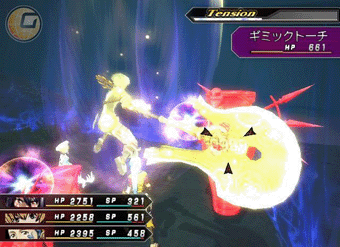Why do people read reviews? I’m sure there are lots of reasons, like they want to read bad reviews so they can link them on GameFAQs in a topic called “ROFL this reviewer sucks,” in which they can berate the reviewer and pick apart his review because, clearly, whatever game we are talking about is the greatest game there has ever been and ever will be. But aside from that most obvious of reasons, I’m willing to bet that at least a few people read reviews to help them figure out whether or not they should get the game being reviewed. This next paragraph is for those very people.
When you are talking about the final game in a series of games that directly follow one another in terms of, well, everything (story, gameplay, etc), the decision of whether to buy or not buy the game should be very easy. To make it even easier, I’ve made up a list of questions to ask yourself to help you get your thoughts in order:
1. Did you play the first two .hack//G.U. games?
a. If you answered “yes,” did you enjoy the games?
If you answered “no” to the question or its sub-question, then do not bother with this game. It’s not a magical disc that will suddenly make you stop hating .hack. It, in many ways, is identical to its predecessors. This, of course, means that if you really liked the previous games, then you should definitely pick this one up.
Now that we’ve gotten that out of the way, I think it’ll be best to do this review like I did the last review. I already went into details about specific whatevers back in my first G.U. review (or at least I think I did…it’s been a while. Oh well!) and I don’t much feel like doing it again. I also just provided you with all the information you need to know to figure out whether or not to buy this game. So, honestly, I should just stop right here and go write …of the Month. You’ve got what you came for, so be off. I know you see more paragraphs below this one, but never mind them. They are not for you; they are for me. See ya!
Alright guys, I’ll let you in on a little secret. This next bit is really for us, not me. I just wanted to be rid of all the softcore readers so we could have a more intimate second half of this review. In this intimate half, I intend to cover the things that I think make Volume 3 stand out from Volumes 1 and 2. Yes, that is the exact same thing I did for my Volume 2 review. Very smart of you to pick that up.
Yet again in this Volume, Haseo gets to use another type of weapon. This time it is dual guns, and not only can you use them like regular weapons, but they come with a handy ability that lets you do a second, mini-skill trigger after you do the first. For example, you can be using the scythe, then perform a skill trigger that requires a broad sword. This will automatically switch your weapons and have you perform the move. Immediately after the move finishes, you can press a button and the special move will activate. This does some extra damage, and then leaves you using the dual guns. Being able to transition from one weapon to the next to the next like that is really handy, especially since you never have to go back to the menu to do any of this switching. You can also very easily choose NOT to do the extra gun move, if you do not feel like using the dual guns. Being forced to do something is never any fun.
While speaking of fun, I should mention that the character roster for this game virtually doubles. Granted, most of the characters are accessible only after you beat the game, but the fact that there are so many of them compared to the other Volumes is a big plus. When it comes to party members, the more, the merrier. More options = less boredom.
Speaking of boredom (my transitions are on FIRE this month) there is a 100-level dungeon you can play after you beat the game. This is more or less the same kind of thing you did in Volumes 1 and 2, where you had a bonus dungeon after the game, only this one is 100-times bigger. The problem with 100-level dungeons is that they are 100 levels long. Does anyone reeeally want to play 100 levels of a single dungeon? Fortunately, there are some mildly interesting “trials” to overcome along the way that help break the monotony. After 50 levels, things get a bit more challenging, but nothing in the dungeon is really very tough to beat. Fortunately, there are save points all over the place, so you can take the dungeon apart piece by piece. You can also leave the dungeon and go back to any floor you’ve visited above level 51. This helps a bit, I suppose. I don’t know, I didn’t leave until after I beat it.
Fortunately, there are a few blessings that make the dungeon worthwhile. At level 50, you get a new party member, and at level 100 after you beat a boss you are rewarded with the best set of dual guns in the game. Woo!
Basically, the theme of this Volume is “more.” There are more types of dungeons to explore, more characters, more enemies, more items and equipment, more bike parts, more quests, more towns, more marriage scenes, etc. If you liked the previous games and just wanted to experience a lot more of what you’ve been getting, then this delivers. If you were looking for a groundbreaking element to the series that would change the way you’ve been looking at .hack…well, uh…sorry.


